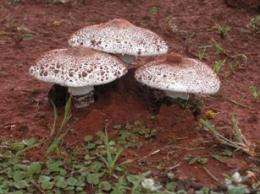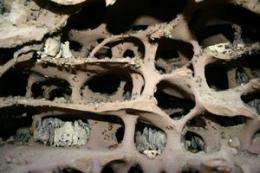Termitomyces mushrooms appearing on top of a colony of fungus-growing termites (photo: Z.W. de Beer)
(PhysOrg.com) -- Food production of modern human societies is mostly based on large-scale monoculture crops, but it now appears that advanced insect societies have the same practice. Our societies took just ten thousand years of (mainly cultural) evolution to adopt this habit and we are far from convinced that it is sustainable.
Farming ants and termites had tens of millions of years to evolve their fungus farming systems and here monocultures are apparently evolutionary stable. In a publication in the journal Science this week, researchers from the Laboratory of Genetics of Wageningen University and the Centre for Social Evolution at the University of Copenhagen take significant steps to resolve this puzzle.
The fungus-growing termites of the old-world tropics build impressive mounds consisting of thousands of workers and soldiers. These societies domesticated African Termitomyces mushrooms more than 30 million years ago and became obligatorily dependent on farming their own fungal food in their often gigantic nest mounds. The termite fungus-farming symbiosis had a single African rain-forest origin and now comprises ca 330 species. It is of major ecological importance for decomposition and mineralcycling.
A colony-founding termite queen and king normally do not acquire their first garden until they have raised the first workers. These helpers collect Termitomyces spores while foraging, together with the plant material that they defecate in the nest to establish a garden substrate. These spores are amply available because the fungus gardens produce large mushrooms once a year on top of the termite mounds.
However, this farming practice offers a paradox: Evolutionary theory predicts that symbioses with multiple lineages per colony should be unstable, because these genotypes can be expected to compete for making mushrooms rather than collaborate to serve the termite farmers.
The inside of a colony of Macrotermes natalensis in South Africa. Fungus gardens are arranged in an interconnected network of chambers, each containing a mass of masticated plant substrate in which Termitomyces grows (photo: D.K. Aanen).
The new study shows that a very special mechanism is in place to prevent this from happening. All colonies from which multiple fungal samples were genetically analyzed contained only a single fungal genotype in spite of gardens having been initiated from at least two and probably many more genetically different spores.
Duur Aanen, Koos Boomsma and their respective colleagues in Wageningen and Copenhagen show that genotypes that happen to be common in a garden, become even more common at the expense of rarer genotypes. This happens not because common genotypes are better direct competitors, but because they have a higher chance of having an identical genotype as neighbor. Every time this happens, such genetically identical mycelia merge, which enhances the efficiency by which they produce asexual spores that the termites eat and deposit in new garden material of the colony. This process of positive reinforcement makes every colony end up with a life-time commitment to a single fungal symbiont in spite of the population at large having many fungal genotypes.
More information: Aanen, D.K., De Fine Licht, H.H., Debets, A.J.M., Kerstes, N.A.G. Hoekstra, R.F. & Boomsma J.J. High symbiont relatedness stabilizes mutualistic cooperation in fungus-growing termites. Science 20 november 2009
Provided by Wageningen University























